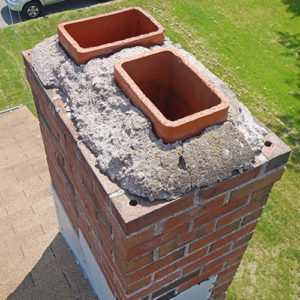Common Causes of Leaky Chimneys & Other Chimney Moisture Damage
An online search for causes of chimney moisture damage will reveal that many different issues result in moisture intrusion. Moisture is Enemy Number One for chimneys, largely because bricks are like sponges. When chimneys are built properly, every feature contributes to protection against moisture. However, there is a tendency for each component to deteriorate and allow the moisture to get into bricks. Read on to learn about the common causes of chimney moisture damage.
Chimney Crown Damage 
The white part of the chimney at the very top is the chimney crown, and its edges are sloped or beveled for the purpose of guiding water away from the chimney itself. Chimney crowns are subjected to harsh weather conditions and tend to deteriorate more quickly than other chimney components.
An important function of chimney crowns is to prevent water from entering the chimney system between the chimney lining and the chimney exterior. When cracks and other kinds of deterioration develop, the likelihood of chimney leaks is increased.
Rusted or Faulty Flashing
The metal portion of the chimney is the chimney flashing. The function of flashing is to create a waterproof seal between the chimney and the roof. Flashing metal is prone to rust, which results in chimney leaks. Another major issue with chimney flashing is the difficulty of installing it properly. Chimney sweeps are frequently called to homes and businesses due to faulty flashing and chimney leaks caused by rusted flashing.
Chimney Cap or Chase Cover Issues
Once a chimney is built, it is typically up to the homeowner to order a chimney cap or chase cover. Although they are accessories, chimney caps and chase covers are absolutely essential. Without them, precipitation can pour directly into the chimney flue. Rain, sleet, snow, and hail can all cause moisture damage if they are simply falling directly inside the chimney.
Once chimney caps are installed, they need to be checked during annual chimney inspections because they can suffer damage and allow water to leak into the home.
Damaged Masonry
Leaky chimneys are often the result of crumbling mortar, missing bricks, and gaps, such as cracks in the chimney. Cracked chimneys cause the chimney system to be even more vulnerable. When water gets into the chimney masonry system, freezing winter weather creates irreversible damage to the bricks. The water inside bricks expands and contracts as a result of freezing temperatures. That movement destroys the bricks and they gradually flatten. Leaning chimneys are usually a result of moisture damage.
Chimney mortar lasts only a couple of decades, whereas the masonry itself will last a century or more. Chimney inspections should be scheduled annually, according to leading fire safety experts. One of the many issues chimney sweeps check for during a chimney inspection is mortar damage. It is good to catch mortar damage early, before moisture has entered the system. Tuckpointing can be performed, which means that the old mortar is removed and new mortar is applied. The alternative is for damaged mortar to allow water to infiltrate the bricks. All that can be done once moisture is inside is to tear out the damaged bricks and replace them.
 CSIA-Certified Chimney Sweeps at Guardian Chimney Sweeps
CSIA-Certified Chimney Sweeps at Guardian Chimney Sweeps
Contact Guardian Chimney Sweeps for reliable chimney masonry services. Their CSIA-certified chimney sweeps consistently provide reliable chimney maintenance services. Problems caused by moisture are common, and we specialize in fixing leaky chimneys and masonry damage caused by moisture. Call us today at one of the numbers below.
Toll-free: (888) 306-6069
Conroe: (936) 271-9781
Houston: (713) 401-2011

 Tap to Call Now
Tap to Call Now